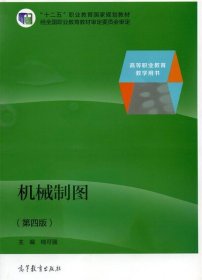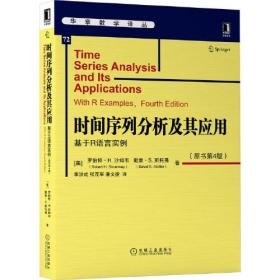
时间序列分析及其应用
¥ 19.05 2.8折 ¥ 69 九五品
仅1件
作者(美)罗伯特沙姆韦 著
出版社世界图书出版公司
ISBN9787510004384
出版时间2009-05
版次1
装帧平装
开本16开
纸张胶版纸
页数575页
定价69元
上书时间2024-07-31
- 最新上架
商品详情
- 品相描述:九五品
- 商品描述
-
基本信息
书名:时间序列分析及其应用
定价:69元
作者:(美)罗伯特沙姆韦 著
出版社:世界图书出版公司
出版日期:2009-05-01
ISBN:9787510004384
字数:
页码:575
版次:1
装帧:平装
开本:大32开
商品重量:
编辑推荐
内容提要
Thegoalsofthiookaretodevelopanappreciationfortherichnessandversatilityofmoderntimeseriesanalysisasatoolforanalyzingdata,andstillmaintainacommitmenttotheoreticalintegrity,asexemplifiedbytheseminalworksofBrillinger(1981)andHannan(1970)andthetextyBrockwellandDavis(1991)andFuller(1995).Theadventofmorepowerfulcomputing,es-peciallyinthelastthreeyears,hasprovidedbothrealdataandnewsoftwarethatcantakeoneconsiderablybeyondthefittingofsimpletimedomainmod-els,suchashavebeenelegantlydescribedinthelandmarkworkofBoxandJenkins(seeBoxetal.,1994).Thiookisdesignedtobeusefulasatextforcoursesintimeseriesonseveraldifferentlevelsandasareferenceworkforpractitionersfacingtheanalysisoftime-correlateddatainthephysical,biological,andsocialsciences.
目录
1 Characteristics of Time Series 1.1 Introduction 1.2 The Nature of Time Series Data 1.3 Time Series Statistical Models 1.4 Measures of Dependence: Autocorrelation and Cross-Correlation 1.5 Stationary Time Series 1.6 Estimation of Correlation 1.7 Vector-Valued and Multidimensional Series Problems2 Time Series Regression and Exploratory Data Analysis 2.1 Introduction 2.2 Classical Regression in the Time Series Context 2.3 Exploratory Data Analysis 2.4 Smoothing in the Time Series Context Problems3 ARIMA Models 3.1 Introduction 3.2 Autoregressive Moving Average Models 3.3 Difference Equations 3.4 Autocorrelation and Partial Autocorrelation Functions 3.5 Forecasting 3.6 Estimation 3.7 Integrated Models for Nonstationary Data 3.8 Building ARIMA Models 3.9 Multiplicative Seasonal ARIMA Models Problems4 Spectral Analysis and Filtering 4.1 Introduction 4.2 Cyclical Behavior and Periodicity 4.3 The Spectral Density 4.4 Periodogram and Discrete Fourier Transform 4.5 Nonparametric Spectral Estimation 4.6 Multiple Series and Cross-Spectra 4.7 Linear Filters 4.8 Parametric Spectral Estimation 4.9 Dynamic Fourier Analysis and Wavelets 4.10 Lagged Regression Models 4.11 Signal Extraction and Optimum Filtering 4.12 Spectral Analysis of Multidimensional Series Problems5 Additional Time Domain Topics 5.1 Introduction 5.2 Long Memory ARMA and Fractional Differencing 5.3 GARCH Models 5.4 Threshold Models 5.5 Regression with Autocorrelated Errors 5.6 Lagged Regression: Transfer Function Modeling 5.7 Multivariate ARMAX Models Problems6 State-Space Models 6.1 Introduction 6.2 Filtering, Smoothing, and Forecasting 6.3 Maximum Likelihood Estimation 6.4 Missing Data Modifications 6.5 Structural Models: Signal Extraction and Forecasting 6.6 ARMAX Models in State-Space Form 6.7 Bootstrapping State-Space Models 6.8 Dynamic Linear Models with Switching 6.9 Nonlinear and Non-normal State-Space Models Using Monte Carlo Methods 6.10 Stochastic Volatility 6.11 State-Space and ARMAX Models for Longitudinal Data Analysis Problems7 Statistical Methods in the Frequency Domain 7.1 Introduction 7.2 Spectral Matrices and Likelihood Functions 7.3 Regression for Jointly Stationary Series 7.4 Regression with Deterministic Inputs 7.5 Random Coefficient Regression 7.6 Analysis of Designed Experiments 7.7 Discrimination and Cluster Analysis 7.8 Principal Components and Factor Analysis 7.9 The Spectral Envelope ProblemsAppendix A: Large Sample Theory A.1 Convergence Modes A.2 Central Limit Theorems A.3 The Mean and Autocorrelation FunctionsAppendix B: Time Domain Theory B.1 Hilbert Spaces and the Projection Theorem B.2 Causal Conditions for ARMA Models B.3 Large Sample Distribution of the AR(p) Conditional Least Squares Estimators B.4 The Wold DecompositionAppendix C: Spectral Domain Theory C.1 Spectral Representation Theorem C.2 Large Sample Distribution of the DFT and Smoothed Periodogram C.3 The Complex Multivariate Normal Distribution ReferencesIndex
作者介绍
序言
-

【封面】
相关推荐
— 没有更多了 —

















以下为对购买帮助不大的评价